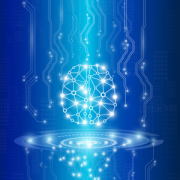AMPLIFY VOL. 36, NO. 8

Technological evolution and increased artificial intelligence (AI) adoption are driving interest in the challenges AI poses for legal frameworks designed to regulate human behaviors. In the context of intellectual property (IP) law, many tasks done by today’s AI are longstanding AI capabilities, but the technology has improved to the point where they have meaningful commercial value.
Those improved capabilities are increasing concerns about the protectability of AI output, deepfakes, privacy, and the use of copyright-protected content for training AI systems. This article focuses on AI-generated output created without a traditional human author or inventor and examines whether this output is protectable under current laws. It also describes a series of legal test cases put forth by the Artificial Inventor Project (AIP).1
Is AI Merely a Tool Used by Humans?
Nearly seven decades after the term “artificial intelligence” was coined, it lacks a uniform definition — and the need to define AI has now departed the realm of academia. This lack has neither impeded engineers nor businesses from developing and employing AI, but it poses substantial challenges for legislation like EU’s AI Act, aimed at governing AI use and development. The same applies to defining AI-generated output, which is muddled by ambiguous terms like “autonomous” and “tool” commonly used to describe AI abilities and functions.
Here, we use “AI” to refer to an algorithm or machine capable of completing tasks that would otherwise require cognition. We use “AI-generated” works and inventions to refer to output made without a traditional human author or inventor.2 AI systems are developed and directed by humans but can, to varying degrees, automate tasks and make creative or technical decisions.
Some argue that AI systems are just tools used by people to generate works and inventions, not different in kind from a pencil or a microscope.3 In this view, AI output is simply a natural extension of human creativity. Others argue that, in some instances, AI is stepping into the shoes of natural persons and automating tasks that would traditionally make a person an author or inventor, including in cases where no natural person is acting as an author or inventor. If this view is correct, it may not be possible to obtain copyright and patent protection for AI-generated output in jurisdictions that require the involvement of a human author or inventor.
Policymakers have become acutely aware of the disruptive nature of AI and are actively debating how best to regulate it. In the US, the Senate Subcommittee on Intellectual Property held a hearing in June 2023 on AI and patents as part of a series on AI and IP.4 The US Patent and Trademark Office issued a “Request for Comments” on AI and patent inventorship in February 2023.5
The EU is creating a new legal framework specifically targeted to AI: the AI Act.6 The UK Intellectual Property Office (UKIPO) conducted two consultations on IP and AI as part of its National AI Strategy.7 The World Intellectual Property Organization (WIPO), the UN agency primarily responsible for IP matters, is conducting a series of meetings on IP and AI as part of its “WIPO Conversations on IP and Frontier Technologies.” WIPO describes the conversations as “an open, inclusive, multi-stakeholder forum designed to provide stakeholders with a leading, global setting to discuss the impact of frontier technologies on all IP rights and to bridge the existing information gap in this fast-moving and complex field.”8
Authorship & Inventorship in IP
One of the primary challenges in determining whether AI-generated output is eligible for protection is that many existing legal systems have, to some extent, framed authorship and inventorship in terms of human activity. Sometimes this was the result of historical assumptions that only a person could be an author or inventor. Some commentators say this is still a desirable position on the basis that IP laws should exist to incent certain human behaviors or protect human moral rights. Others argue that IP laws exist primarily to benefit the public by encouraging the creation and dissemination of IP and thus should be agnostic as to the manner in which protectable output is generated.
Establishing IP rights for AI-generated output may also raise new questions about ownership. Whereas authors and inventors are sometimes the first-instance owners of their output, AI systems, lacking in legal personality, cannot own IP. It thus becomes necessary to determine who should hold the corresponding rights — including in cases where multiple parties may have a claim to ownership, such as those programming or training AI systems, using AI systems, or having ownership rights in AI systems. Adding further complexity, IP law is governed by a complex web of national and international rules.
The Artificial Inventor Project
AIP is a global initiative that:
... includes a series of pro-bono legal test cases seeking intellectual property rights for AI-generated output in the absence of a traditional human inventor or author. It is intended to promote dialogue about the social, economic, and legal impact of frontier technologies such as AI and to generate stakeholder guidance on the protectability of AI-generated output.9
In 2018, AIP filed two patent applications for AI-generated inventions to UKIPO and the European Patent Office (EPO).10 The applications pertained to a beverage container based on fractal geometry and an emergency beacon, both devised by an AI system called DABUS (Device for the Autonomous Bootstrapping of Unified Sentience), which is created, owned, and operated by Dr. Stephen Thaler.11 DABUS was not provided with a specific problem to solve, and Thaler lacked technical expertise in the fields of DABUS’s output.12
The patent applications successfully passed a preliminary substantive examination by UKIPO, after which an inventorship designation was filed to disclose that the inventor for both applications was DABUS rather than a natural person. Thaler was listed as the patent applicant and thus owner of any property rights in the applications and any future issued patents.
From there, an “international” patent application was filed under the Patent Cooperation Treaty,13 and the application was ultimately nationalized in 18 jurisdictions: Australia, Brazil, Canada, China, EPO, Germany, India, Israel, Japan, New Zealand, Republic of Korea, Saudi Arabia, Singapore, South Africa, Switzerland, Taiwan, the UK, and the US.14
DABUS was named as the legal inventor, not to grant rights to a machine (AI lacks legal personality and rights) but because it was the factual inventor and to maintain transparency about the origin of the inventions. Although DABUS is the first AI inventor to be listed on an application, it is not unusual for human inventors to have no rights to patents on their inventions. Most patents are owned by artificial entities, such as corporations, which typically acquire these rights through employment relationships.
No statute explicitly governs the ownership of patents on AI-generated inventions, but longstanding property law principles suggest that the AI’s owner should own these patents. For example, the owner of a 3D printer owns the physical objects produced by his or her machine. In some jurisdictions, people who employ computer software and hardware to generate (aka “mine”) cryptocurrencies own that cryptocurrency.
These examples follow a rule sometimes referred to as “accession,” which dates back to at least Roman law and dictates that property owners own property created by their property, whether it is fruit from a tree or a calf from a cow. Similarly, if someone owns a machine, he or she should own the output of that machine, whether tangible or intangible. This outcome is crucial given the intangible, non-rivalrous nature of AI output.
Securing patents on AI-generated inventions is essential for achieving patent law’s policy objectives. It fosters innovation by encouraging the use and development of inventive AI, since the output generated by these machines will be more valuable. It also promotes public disclosure of AI-generated inventions that could be protected as trade secrets or confidential information and incents the commercialization of inventions.
In some industries, where patent protection is critical to business models like drug development, most costs associated with an invention arise not from initial discovery but from subsequent development expenses required to turn a discovery into a marketable product. In the case of new drugs, clinical validation can cost hundreds of millions of dollars. Allowing patents on AI-generated inventions enables businesses that rely on patent protection to automate aspects of R&D, without facing legal penalties, if it offers a technical advantage.
So far, AIP applications have received final, non-appealable denials in three jurisdictions: the US, Australia, and Taiwan.15 South Africa granted the patents,16 and the patent office of Saudi Arabia has accepted the designation of DABUS as the inventor and is conducting substantive examination. In five other jurisdictions (EPO, Germany, Israel, New Zealand, and the UK), the applications are undergoing judicial appeals after being rejected by patent offices. Of note, the UK Supreme Court heard oral arguments in the case in March 2023.17 In the remaining jurisdictions, the applications either await examination or have received preliminary rejections from patent offices that are still being internally appealed.
In addition to the patent filings, in November 2018, AIP applied to register an artwork created by DABUS with the US Copyright Office (USCO).18 The application identified the AI as the author and sought ownership rights for Thaler as the AI’s owner. However, on 14 February 2022, USCO issued a final rejection based on its policy that human authorship is a prerequisite for copyright protection in the US and said the work could not be registered.19
On behalf of Thaler, AIP filed a lawsuit against USCO on 2 June 2022, arguing that the Copyright Act permits copyright for AI-generated works and AI authorship and that the owner of an AI should be entitled to copyright in an AI-generated work.20 While that case makes its way through the courts, on 16 March 2023, USCO released “Copyright Registration Guidance: Works Containing Material Generated by Artificial Intelligence,” which stated that “if a work’s traditional elements of authorship were produced by a machine, the work lacks human authorship and the Office will not register it.”21 They continued discussing AI-assisted works, saying:
When an AI technology determines the expressive elements of its output, the generated material is not the product of human authorship. As a result, that material is not protected by copyright and must be disclaimed in a registration application.22
As generative AI becomes integrated into widely used consumer software like Microsoft Word, Gmail, and Adobe Photoshop, this level of parsing of human versus machine involvement will be increasingly difficult. We will likely see a continued reevaluation of this policy as the ubiquitous nature of these technologies becomes clear.
Unlike the US, the UK and other jurisdictions explicitly allow the protection of AI-generated works. In the UK, such works receive a limited term of protection compared to traditional author works (50 years from the year of creation versus the life an author plus 70 years), and the producer of the work is legally deemed or fictionalized to be the author.23 Since the UK elected to protect AI-generated works under Section 93 of the 1988 Copyright, Designs and Patents Act, the law has only been at issue in one case, and even then only tangentially, as no party was challenging the subsistence of the underlying work.24
Concluding Thoughts
As AI systems advance and produce increasingly sophisticated and innovative output, the question of how to treat this output under IP law becomes more pressing. The characteristics of some AI systems, including the self-improving nature of certain AI models and the difficulties associated with attributing their outputs to human creators, challenge the existing framework and necessitate a thorough rethinking of what rules will result in the greatest social value.
The treatment of AI-generated output under IP law is complex and evolving. As various jurisdictions grapple with the challenges presented by AI-generated works and inventions, international harmonization and cooperation will be crucial to develop a coherent and efficient legal framework.
Ultimately, reconciling the diverse approaches and addressing the legal, ethical, and economic implications of AI-generated output will be essential to foster innovation, promote the responsible use of AI, and ensure the equitable distribution of the benefits arising from AI-generated works and inventions.
References
1 This article is partially adapted from a recent article in the European Intellectual Property Review; see: Abbott, Ryan, and Elizabeth Rothman. “AI-Generated Output and Intellectual Property Rights: Takeaways from the Artificial Inventor Project.” European Intellectual Property Review, January 2023.
2 Abbott, Ryan. The Reasonable Robot: Artificial Intelligence and the Law. Cambridge University Press, 2020.
3 See, for example: Salsberg, Corey. “Novartis Comments on Artificial Intelligence and Inventorship (Docket PTO–P–2022–0045, 88 FR 9492).” Novartis, 15 May 2023.
4 “Artificial Intelligence and Intellectual Property — Part I: Patents, Innovation, and Competition.” Subcommittee on Intellectual Property, US Senate Committee on the Judiciary, 7 June 2023.
5 Patent and Trademark Office, US Department of Commerce. “Request for Comments Regarding Artificial Intelligence and Inventorship.” Federal Register, Vol. 88, No. 30, February 2023.
6 “Proposal for a Regulation of the European Parliament and of the Council: Laying Down Harmonised Rules on Artificial Intelligence (Artificial Intelligence Act) and Amending Certain Union Legislative Acts.” European Commission, 21 April 2021.
7 UK Department for Science, Innovation and Technology; Office for Artificial Intelligence; Department for Digital, Culture, Media & Sport; and Department for Business, Energy & Industrial Strategy. “National AI Strategy.” GOV.UK, 22 September 2021.
8 “Intellectual Property and Frontier Technologies.” World Intellectual Property Organization (WIPO), accessed August 2023.
9 The Artificial Inventor Project website, accessed August 2023.
10 Together with the patent cases, a copyright case was filed in the US to register copyright in an AI-generated work. The US Copyright Office (USCO) rejected the registration; this is the subject of a pending case in US federal court; see: “Thaler v. Perlmutter, et al.” US District Court for the District of Washington DC, 2 June 2022.
11 ”Thaler v. Vidal.” US Court of Appeals for the Federal Circuit, 5 August 2022.
12 For a detailed technical explanation of how DABUS invented the beverage container and emergency beacon, see: Thaler, Stephen L. “Vast Topological Learning and Sentient AGI.” Journal of Artificial Intelligence and Consciousness, Vol. 8, No. 1, 2021.
13 ”PCT — The International Patent System.” World Intellectual Property Organization (WIPO), accessed August 2023.
14 The Artificial Inventor Project (see 9).
15 An updated list of jurisdictions, file/case numbers, and outcomes can be found at The Artificial Inventor Project website (see 9).
16 South Africa Companies and Intellectual Property Commission. “Food Container and Devices and Methods for Attracting Enhanced Attention.” Patent Journal, Vol. 54, No. 07, July 2021.
17 ”Thaler v. Comptroller-General of Patents, Designs and Trademarks.” UK Supreme Court, 2 March 2023.
18 “Thaler v. Perlmutter, et al” (see 10).
19 Perlmutter, Shira. “Re: Second Request for Reconsideration for Refusal to Register A Recent Entrance to Paradise (Correspondence ID 1-3ZPC6C3; SR # 1-7100387071).” Copyright Review Board, US Copyright Office (USCO), 14 February 2022.
20 “Thaler v. Perlmutter, et al” (see 10).
21 US Copyright Office (USCO)/Library of Congress. “Copyright Registration Guidance: Works Containing Material Generated by Artificial Intelligence.” Federal Register, Vol. 88, No. 51, March 2023.
22 US Copyright Office (USCO)/Library of Congress (see 21).
23 “Copyright, Designs and Patents Act 1988.” Legislation.gov.uk/The National Archives, accessed July 2023.
24 “Nova Productions Ltd. v. Mazooma Games Ltd. & Ors.” England and Wales Court of Appeals, 14 March 2007.




